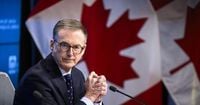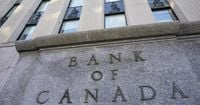OTTAWA – On Wednesday, April 16, 2025, the Bank of Canada (BoC) is poised to announce its latest decision regarding the target for the overnight interest rate. This announcement will take place at 9:45 a.m. ET, alongside the release of its quarterly Monetary Policy Report (MPR). Financial analysts and market experts are closely watching this decision, as it marks a pivotal moment in the central bank's monetary policy amid ongoing trade uncertainties.
The backdrop for this decision is steeped in economic fluctuations, particularly influenced by the trade policies of U.S. President Donald Trump. Since his return to office in January, Trump's administration has implemented tariffs that have created ripples across the Canadian economy. The BoC is expected to maintain its current policy rate at 2.75%, halting a series of seven consecutive rate cuts. This pause comes as the bank reassesses its approach in light of the mounting global uncertainties that have been exacerbated by the U.S. tariff agenda.
At 7:00 a.m. ET, journalists will be permitted to review the rate announcement press release and the MPR under embargo at the Bank's head office in Ottawa, located at 30 Bank Street. To attend, media representatives must confirm their presence by contacting Media Relations before noon on Tuesday, April 15, 2025. The embargo will be lifted at 9:45 a.m., allowing the public to access the information simultaneously.
Following the announcement, Governor Tiff Macklem and Senior Deputy Governor Carolyn Rogers will hold a press conference at 10:30 a.m. ET, where they will delve deeper into the implications of the rate decision and the MPR. The opening statement will also be made available on the Bank’s website at 9:45 a.m. Those wishing to attend the press conference in person must register in advance, while remote participation options will be available for journalists unable to attend.
Market sentiment is rife with speculation about the BoC's next move. Analysts at TD Securities have noted, "We look for the BoC to pause at 2.75% in April as it waits for more clarity around tariff impacts before easing further." This reflects a broader consensus that the central bank is adopting a more cautious stance, focusing on the potential risks posed by U.S. tariffs rather than immediate economic stimulus.
Recent data suggests the Canadian economy is experiencing a complex interplay of factors. Inflation rates have fluctuated, with headline inflation returning to above the BoC’s target after surging to an eight-month high of 2.6% in February. However, the most recent figures showed a drop to 2.3% in March, primarily due to decreases in gasoline and travel prices, offsetting food price increases as the Goods and Services Tax (GST) holiday came to an end. Core inflation measures remain stubbornly elevated, hovering around 3%.
In addition, the BoC's Business Outlook Survey, published on April 7, revealed that Canadian firms and consumers are bracing for a heightened risk of recession in the coming year. The uncertainty surrounding U.S. tariffs has led many companies to pause investment and hiring plans, with employment expectations now lower than at any point during the pandemic. The survey indicated that 65% of firms expect their costs to rise if tariffs become more widespread, prompting 40% of respondents to consider increasing their selling prices.
As the Canadian Dollar (CAD) has shown signs of recovery, appreciating against the U.S. Dollar (USD) to the 1.3840 region from monthly lows around 1.4400, the market is keenly aware of how the BoC's decisions will impact currency movements. Senior Analyst Pablo Piovano from FXStreet highlighted that the USD/CAD pair recently broke below its key 200-day Simple Moving Average (SMA) at 1.3995, suggesting potential further weakness for the U.S. dollar against its Canadian counterpart.
Piovano elaborated, "If the Canadian Dollar extends its recovery, USD/CAD is likely to revisit its 2025 floor at 1.3838, closely followed by the November 2024 trough at 1.3817, and ahead of the September 2024 low at 1.3418." He also noted that while the spot is trading in oversold conditions, a technical bounce should not be ruled out, although the ongoing bearish trend may gain additional strength.
Governor Macklem's upcoming press conference is expected to focus on the implications of U.S. tariffs, as trade policies continue to shape the economic landscape. His previous remarks have indicated a shift in the bank's approach, with less emphasis on economic forecasts and a greater focus on managing risks. Macklem stated, "We need to set policy that minimizes the risk. That means being less forward-looking than normal until the situation is clearer. And it may mean acting quickly when things crystallize." This cautious tone reflects the central bank's commitment to maintaining price stability while navigating a turbulent economic environment.
As the Bank of Canada prepares to make its announcement, the implications of its decision will resonate across financial markets and influence the broader Canadian economy. With trade tensions continuing to loom large, all eyes will be on the central bank's strategy and its potential impact on inflation, interest rates, and the value of the Canadian Dollar.








